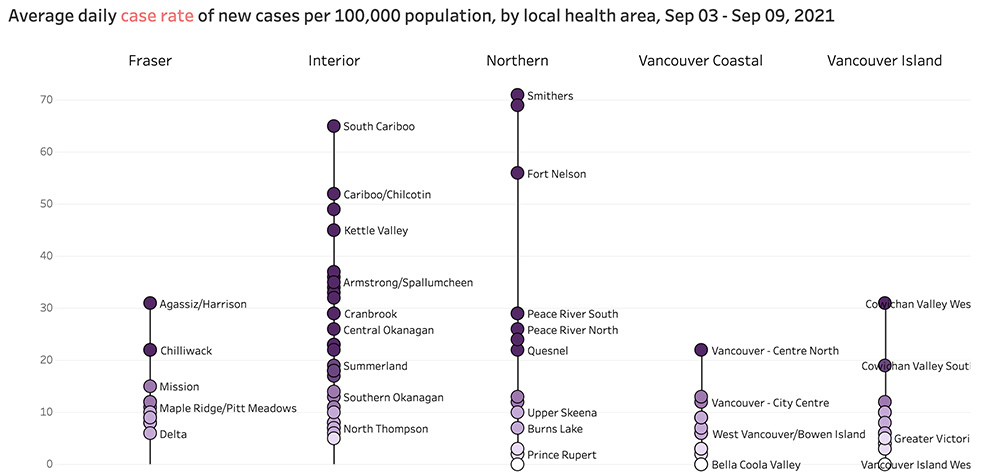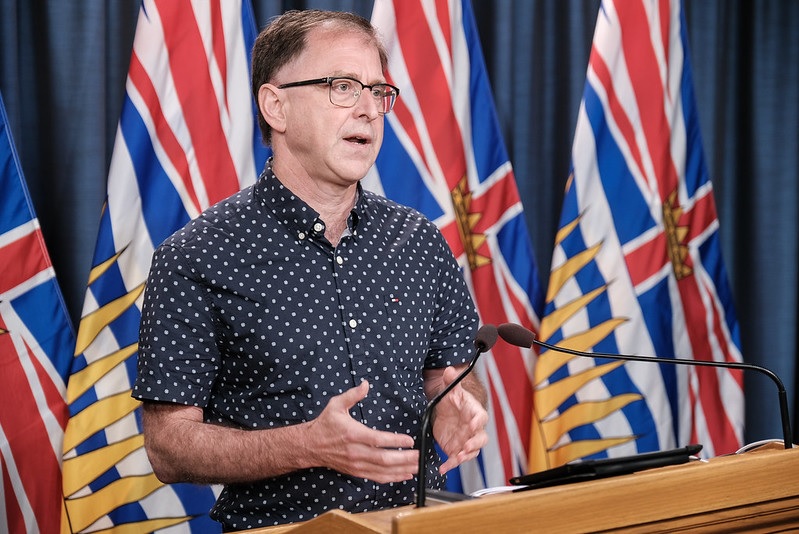The greatest COVID-19 pressure on B.C.’s health-care system has shifted from Metro Vancouver to the province’s northern and interior regions, Health Minister Adrian Dix said Tuesday.
“These numbers are very challenging. I mean, we’ve seen days where there are more than 100 cases [in the Northern Health authority],” Dix said when asked by The Tyee how increasing COVID-19 cases in the North are affecting health-care services.
“We have, given our capacity in the North, a significant number of people in acute care and critical care, so this is a challenge.”
The announcement comes as parts of northern B.C. see some of the highest daily new COVID-19 cases since the start of the pandemic.
Last week, the Smithers local health area topped B.C.’s per-capita case numbers with 71 new positives per 100,000 for a population just under 17,000, including the surrounding communities of Witset, Telkwa and Houston.
That’s almost five times greater than the rate for Vancouver’s city centre.
Smithers was closely followed by the Nechako local health area west of Prince George, which encompasses Vanderhoof, Fort St. James and Fraser Lake, and had 69 positive cases for roughly the same population.
According to the BC Centre for Disease Control, 41 people are currently hospitalized in the North, 16 of them in critical care. The region has six per cent of the province’s population and 15 per cent of B.C.’s total hospitalized COVID-19 patients.
On Tuesday, the province reported 677 new COVID-19 cases, 99 of them — nearly 15 per cent — in Northern Health. The authority’s seven-day rolling average for test positivity rates is nearly 22 per cent compared with 6.5 per cent provincewide.

Dix made his comments during an announcement Tuesday afternoon that the province intends to enhance health-care services in the North with $6.4 million in funding and partnerships for programs that encourage health worker recruitment and retention in the region.
According to the province, a health-care worker rural retention program will target specific communities and occupations by offering financial incentives and support for priority health-care workers, such as travel, child-care and housing programs.
“The program is designed to offer financial incentives and support for health-care workers and will be funded directly by the Ministry of Health — it won’t come out of the Northern Health budget — at approximately $3 million,” Dix said.
Dix added that the measures are part of an announcement coming in the fall about broader actions to secure health-care human resources in the North, calling Tuesday’s announcement “interim actions” to address the region’s immediate issues.
“These measures come together, I think, at an important time in health care across the Northern Health authority,” he said. “We have the highest level of COVID-19 per share of the population in Northern Health of any region in B.C.”
The announcement was made in tandem with a promise to bolster B.C.’s ambulance service, something the province is calling “the largest hiring push in B.C.’s history in rural and remote locations.” Two dozen communities across B.C. will benefit from enhanced services, the province said, and 26 smaller and more remote stations will have more stable paramedic jobs beginning Nov. 1.
Dix added that Tuesday’s announcements went beyond the immediate COVID-19 emergency and represented long-term support for health-care services in northern and rural areas.
But the questions he fielded during the hour-long briefing were primarily related to the COVID-19 pandemic and B.C.’s recently implemented vaccine card.
When asked by The Tyee whether northern regions might be facing further restrictions as COVID-19 numbers climb, Dix pointed to new public health orders introduced last week that restrict gatherings in Northern Health to one additional family or five people total.
“The actions taken specifically for the North last week, which mirror the actions taken for Interior Health, the BC Vaccine Card, the exceptional work that’s being done by our immunizers across the North... these are significant measures,” Dix said. “Of course, we’re going to support northern communities. Today is an example of that.”
Dix didn’t miss any opportunity to promote B.C.’s vaccination program, which has lagged in areas of the North, acknowledging there is “more work to go on immunization” in the region.
In Northern Health, Dix said 74 per cent of residents have their first dose; 64 per cent are fully vaccinated. That’s compared with 86 per cent of B.C. residents provincewide who have their first dose and 79 per cent who are fully vaccinated.
According to the BCCDC, Peace River and Fort Nelson in B.C.’s northeast have the province’s lowest vaccine rates with about 50 per cent of eligible residents receiving their second dose. In Nechako, 58 per cent of residents have received two doses and in Smithers, 62 per cent.
Following vaccine shortages in the spring, Dix said there are now enough doses for everyone to get the shot.
“Now we have vaccine for all those who will want it,” he said. “With that in mind, I want to encourage everybody in the North to get vaccinated.” ![]()
Read more: Coronavirus
















Tyee Commenting Guidelines
Comments that violate guidelines risk being deleted, and violations may result in a temporary or permanent user ban. Maintain the spirit of good conversation to stay in the discussion.
*Please note The Tyee is not a forum for spreading misinformation about COVID-19, denying its existence or minimizing its risk to public health.
Do:
Do not: